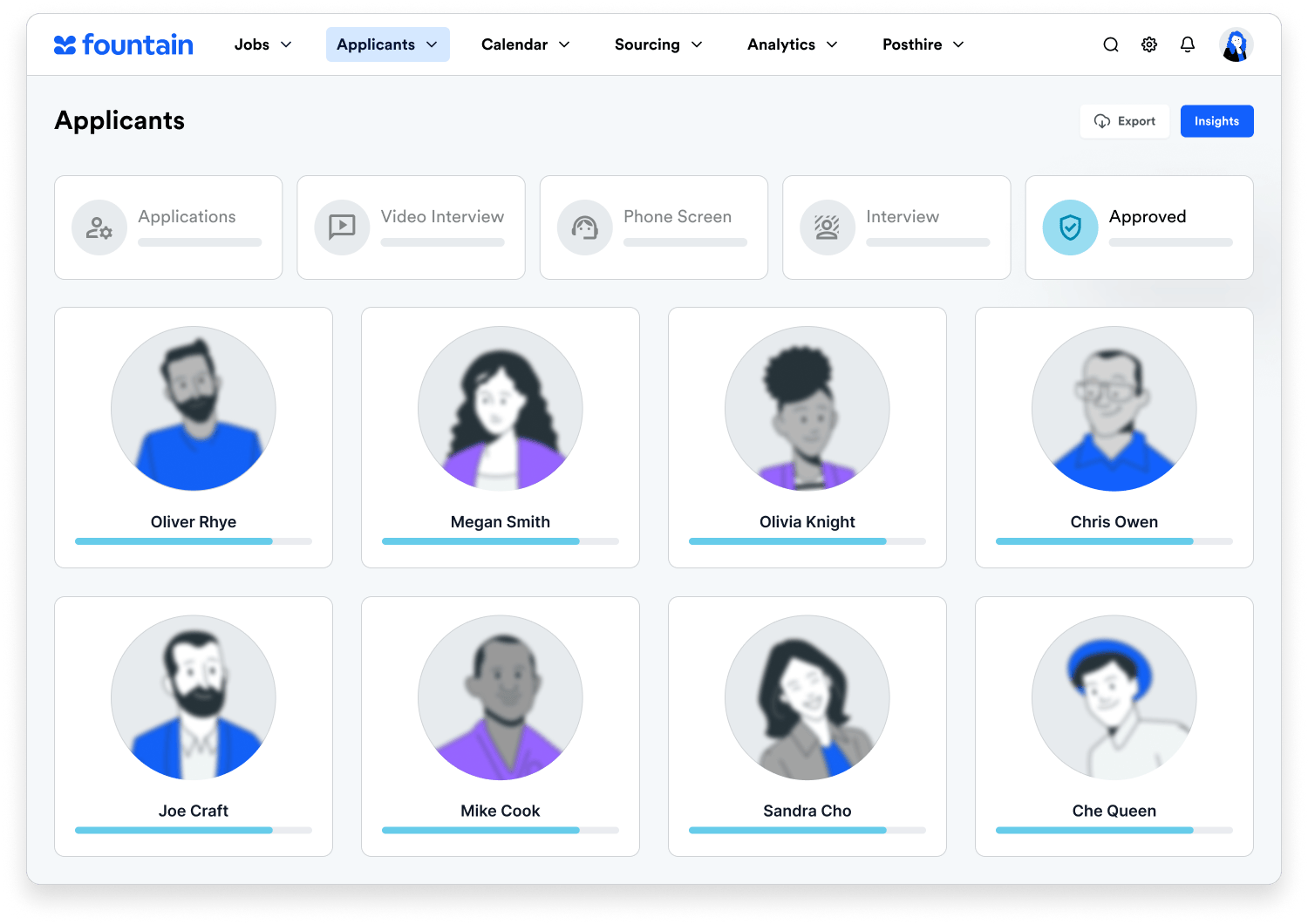What makes a business successful? Answer: It’s not always all about revenue and growth.
It’s knowing how to efficiently recruit, hire, and retain the right people, who can help you reach those revenue and growth goals.
To get the right people on board, you first need to examine whether you’re employing the right recruiting type for your personnel needs. Depending on how your organization operates, you’re likely either hiring corporate workers (also known as salaried or knowledge workers) or hourly workers (also called frontline workers).
While it may seem intuitive to use one hiring process for all types of workers, there are key differences to keep in mind when it comes to how you hire depending on who you hire. Keep reading to learn more about the differences between corporate and high volume hiring.
Corporate hiring vs. high volume hiring
Corporate hiring involves hiring workers who are salaried and perform specialized functions within a company. Job titles can range from an Account Executive to a Director of Engineering. Regardless of the occupation, these workers typically have a stronger online presence. They likely have detailed LinkedIn profiles, resumes tailored to specific roles, and their experience tends to be in the same industry throughout their career.
On the other hand, an hourly worker’s role is typically not as specialized. Job titles can include a cashier, grocery delivery driver, restaurant server, or long-haul truck driver. These are jobs that require less prior experience, so candidates for these jobs typically have a minimal online presence. They’re also more likely to work multiple jobs at the same time.
The differences between these types of workers can (and should) affect the way you screen and evaluate candidates. Let’s explore what hiring looks like for corporate workers versus hourly workers.

What does an efficient recruiting process look like?
Every recruiter wants their hiring process to be efficient. But what does that mean?
To start, an efficient corporate recruiting system requires alignment with the hiring team. Each member of the team should have a clear understanding of what stage of the process they’re involved in and why. Without this alignment, you run the risk of recruiters feeling unprepared for their tasks.
If your personnel needs require high volume hiring, you may be hiring for multiple positions across different locations. You may also be in full charge of the application, qualification, and hiring of these employees. An efficient process for you will be as simple and automated as possible while ensuring candidates have a seamless and positive experience.
In short, corporate recruiting is typically more involved, strategic, and manual while hourly recruiting tends to be more individual, simple, and automated.
Sourcing
To source quality candidates for any role requires considerable planning and consistent execution by the hiring team. Here, we dive into what that looks like for the two types of recruitment.
Corporate
Corporate sourcing may involve the use of professional networks and even in-person network events to find the right candidates. Alumni associations, professional organizations, and job sites like LinkedIn are popular resources for corporate recruiters.
High volume hiring
Recruiters who hire high volumes of workers need to be able to reach a much larger pool of job seekers. They tend to source using free and paid job boards like Indeed and cast a wide-yet-specific net to attract the right people.
Applications
Corporate
Corporate recruiters usually want to review a lot of information upfront. During this part of the application process, they will carefully vet the candidate’s work experience, relevancy, and professional accomplishments. These candidates might even have measurable proof of their success, such as quotas met or number of accounts closed.Recruiters who hire corporate workers may find gaps in employment to be cause for alarm, but this is becoming less of an issue with time.
High volume hiring
When hiring hourly workers, recruiters require significantly less information upfront. Most workers won’t have a resume and/or a resume is unnecessary for the role. In the world of high volume hiring, most recruiters’ efforts will revolve around reducing the friction between the application and getting applicants into the pipeline.
Hourly workers’ prior work experience doesn’t have to relate to the job they’re applying for, but some high volume recruiters get into trouble when they narrow their search using this parameter.

Consider alternatives to the traditional application process: Text-to-Apply is becoming increasingly popular in the hourly recruiting space. Text messages have a 98% open rate, compared to email at 22%.
With 70% of hourly workers applying to multiple jobs at the same time, making the application process easier and faster will dramatically increase the number of candidates you’re able to get into your pipeline.
Interviews
Corporate
For a corporate position, you’ll likely have multiple interview stages and multiple stakeholders involved in the decision-making process. Candidates will go through an average of three rounds of interviews, a number that may increase for more senior positions.
High volume hiring
With hourly recruiting, you’ll take a different approach. Considering 70% of hourly workers seek work at multiple jobs at the same time, they value a simple interview process.
You may find that using asynchronous video interviews is the most time-efficient way to see how hourly candidates’ personalities come across. Other options are one-on-one video interviews or in-person interviews
Tips for hiring the best talent through high volume hiring
Regardless of who you’re hiring, all recruiters want the same thing: a straightforward hiring process that gets the best candidates to the finish line as easily as possible.
To accomplish this, here are a few ways recruiters can optimize their hiring processes to win the race for talent and keep their operations moving swiftly.
Build a talent pool to feed your pipeline
A robust applicant tracking system (ATS) should be able to store candidate information, even for those candidates who don’t make it to the hiring stage. When you have new roles to fill, you can refer to this pool of candidates who previously applied and reach out to see if they’re still looking for a job. This will help you create and maintain a steady stream of applicants who can be ready to work at a moment’s notice.
Get more tips and tools for your high volume hiring process.
Reduce time spent in the interview stage
In the final stages of recruiting, you can just as often be selling the candidate on the opportunity as much as you are assessing their capabilities. With 73% of candidates considered to be “passive” job seekers and top candidates only available for approximately 10 days before they get hired, you need to move quickly for the right person.

This doesn’t mean you should break your process and start over. Instead, you should expedite it. For example, the average interview process is 22.9 days, but there’s no way an hourly candidate will wait this long for this step. Each step in the interview process contributes to the length, so reducing the time between steps will shorten your process and allow you to hire the best talent.
To solve this, enable your candidates to schedule their interviews right away by linking with recruiters’ calendars to see available timeslots, or even allow candidates to complete interviews async so recruiters can view them at their leisure.
Use automation to keep things flowing
Automated workflows help guide candidates through every stage of the hiring process, only involving recruiters in stages that need the human touch. This allows for speed, continuity, and a simpler process for both recruiters and candidates, and gives recruiters more time to devote to tasks that require their attention.
Examples of such automation can include document-uploading capabilities that scan identification information, automated interview scheduling, and even AI-powered chatbots to answer candidates’ common application questions.
The Fountain approach to faster high volume hiring
Fountain was built specifically with the hourly worker in mind. As a leading tech-powered ATS, Fountain can manage thousands of candidates at the same time. With robust data and analytics features, recruiting teams can learn how their hiring process is performing and make real-time improvements as needed.
Automation and AI put key steps of the recruiting process in the hands of candidates, keep them informed of their application status, and allow them to schedule time with recruiters for interviews and other pressing needs.

